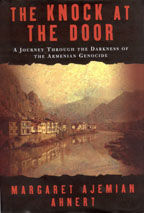Our stories reveal the true nature of history
Published 5:11 pm Monday, July 2, 2007

- Margeret Ajemian Ahnert's book "The Knock at the Door: A Journey through the Darkness of the Armenian Genocide," was published this spring by Beaufort Books.
By David Joyner
CNHI News Service
Ester Minerajian Ahronian Ajemian was 20 when she fled her hometown in the waning days of the Ottoman Empire. World War I was finished, and she scarcely could find traces of her family and what was once a thriving Armenian community near the Black Sea.
Most had been forced from their homes and killed during five years of atrocities committed against Christian Armenians at the hands of soldiers, who were Islamic Turks. Ester would say later, “The only thing I brought with me to America was my memory – the thing I most wanted to leave behind.”
Nearly 80 years later, while residing in a home for Armenian seniors in New York, she reached into her past to describe these memories for her daughter, Margaret Ajemian Ahnert.
A woman once defenseless to soldiers who forced her from the family home had fashioned a powerful tool – a personal account of their awful deeds.
Ester’s story is preserved in her daughter’s book, “The Knock at the Door: A Journey through the Darkness of the Armenian Genocide,” published this spring by Beaufort Books. It shows how a human voice – amplified by a book, Web site or newspaper – can rise above clouds of dates and political debate to bear witness to history.
Everybody likes a good story, and stories can be a fluid commodity, swapped over a long-distance connection or passed with the green beans at dinner.
But stories – especially firsthand accounts – do more than entertain. They are the narrative of human experience. They reveal our past: what people did, why they did it, how those events affected others.
Put to writing, they have a particular way of setting and fixing the past, ensuring that it cannot be wiped clean.
Such is the work of Elie Wiesel, the Holocaust survivor whose novels tell about the atrocities committed by the Nazis and who won the Nobel Peace Prize in 1986. It is the work of Aleksandr Solzhenitsyn, another Nobel laureate who chronicled Soviet labor camps that sucked the life from their prisoners. And, similarly, it is Ester’s recollections of the brutality inflicted upon the Armenian people.
Most stories are less sweeping in scope, but nonetheless they help us to comprehend the past.
They may be immediate, such as the stories shared recently by reporters at The Eagle-Tribune of North Andover, Mass., who detailed the angst and hope of the family of U.S. Army Specialist Alex R. Jimenez of Lawrence, Mass. Jimenez was kidnapped last month by al-Qaida militants in Iraq and has not been seen since. His family’s experience is sure to be one that endures to define the emotional toll inflicted by war upon families and communities.
Stories also illuminate what is past, such as those being collected this summer by reporters and editors at the Johnstown, Pa., Tribune-Democrat about the flood that struck the community in 1977 and claimed 85 lives. The newspaper has prepared a book that compiles the accounts of those who survived and rebuilt their community.
The underlying power of these intimate stories is their ability to capture history before it slips away.
Ester’s story is important for that reason, but also because of the controversy that surrounds what happened to her and other Armenians living in the Ottoman Empire at the time.
“A Knock at the Door” recalls the atrocities that began April 24, 1915, during World War I, when the government gathered and killed hundreds of Armenian leaders, presumably for their sympathy to Russia. Historians have recorded that Turkish soldiers killed hundreds of thousands of others – as many as 1.5 million – over the years that followed.
Those who study the systematic killing of ethnic groups recognize this as the 20th century’s first genocide. Modern Turks dispute that description, saying many Armenians died as part of the greater casualties during World War I.
There’s no doubt in Ester’s story about what happened. Her personal horror started when soldiers took her adoptive father, whom she never saw again. She was marched from her hometown of Amasia, attacked by soldiers and left for dead.
She was discovered and turned in at an orphanage, where brutality and torture continued. She was ultimately taken as a wife, and her identity stripped from her, before she found the courage and hope necessary to escape.
Like any important story, Ester’s rises above the din of political debate. And while it may not settle the controversy, her story will at least endure to remind us of a dark chapter in history and maybe bring us closer to the truth.
David Joyner is executive news editor of Community Newspaper Holdings Inc. He may be reached at djoyner@cnhi.com.





